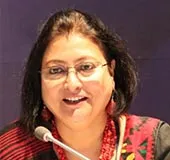-
CENTRES
Progammes & Centres
Location
 PDF Download
PDF Download 
Anasua Basu Ray Chaudhury | Pratnashree Basu NOV 26 2015
India and its neighbour, Myanmar, have had a long history of friendly relations, tied by strong bonds of shared history and commonalities in culture and spirituality. In the 1990s, however, these relations gathered a new momentum. It was then that India launched its Look East Policy (LEP), marking a significant shift in India’s vision in foreign policy and its place in the international arena. Since then, India and Myanmar’s relations have received a boost from more aggressive initiatives in forging formal agreements and deepening economic, political, cultural and people-to-people ties between them. The administration of Prime Minister Narendra Modi, elected in 2014, remains committed to the LEP, which it had renamed ‘Act East’ since then.
Myanmar shares a 1,600-km-long land border with India, as well as a maritime boundary in the Bay of Bengal; this geographical proximity alone has influenced their bilateral relations, making the two countries important strategic partners for one another. Myanmar serves as a ‘land-bridge’ between India and South East Asia and, beyond that, East Asia—a harbinger of friendly engagements for India and these neighbouring regions. For India, its relationship with Myanmar is integral to its Act East policy, in the pursuit of a more stable, secure and prosperous Asia and the surrounding Indian Ocean and Pacific regions. Connectivity, therefore, between India and Myanmar is essential to India.
Holding more promise for closer India-Myanmar relations is the latter’s ongoing journey towards democratisation, which began when military rule ended in 2011 and Myanmar embarked on economic and political reforms. In the past few years, parliamentarians from Myanmar have been coming to India to learn parliamentary practices and procedures. India, after all, is the second largest democracy in the world and can teach valuable lessons to its neighbour, whose growth was for a long time stunted by the absence of democracy. The growing India-Myanmar partnership, therefore, is not only defined by development cooperation but also by its twin, capacity building.
The views expressed above belong to the author(s). ORF research and analyses now available on Telegram! Click here to access our curated content — blogs, longforms and interviews.

Anasua Basu Ray Chaudhury is Senior Fellow with ORF’s Neighbourhood Initiative. She is the Editor, ORF Bangla. She specialises in regional and sub-regional cooperation in ...
Read More +
Pratnashree Basu is an Associate Fellow, Indo-Pacific at Observer Research Foundation, Kolkata, with the Strategic Studies Programme and the Centre for New Economic Diplomacy. She ...
Read More +